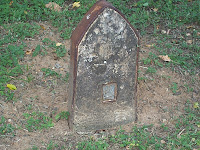I ended up taking my chitty chitty bang bang truck that blows black smoke into the environment to the local cemetery. Yeah I don't like it either but a girl has got to get out of the house sometimes, even if it means getting stranded in town and having to pay for the truck to get towed back home. Thankfully that didn't happen.

Now most folks like to keep their distance from cemeteries, but I find them fascinating, intriguing, educational, appealing and mysterious. The curiosity of who this person was, did they have family, are their family here already? History, it's all about history. Personal history, town history, cultural history, religious history and even era history.
This little towns history is very visual in its cemetery. The time line of population booms and even economics can be learned if you look hard enough.
The first thing I noticed when I started walking through was that it was at one time a segregated cemetery. The poor and Mexican/Hispanic (who at the time where mostly farm workers, coal miners) were to the left and the whites/landowners to the right.
This was evident just at first glance. Here, even today the (lets just go with) Hispanics tend to decorate the graves with ornate objects such as lots of fake flowers and little (or really big ones) religious figurines. The catholic religion is prominent and visible through out the whole left side.

The first old stone I looked at on the left side was in Spanish. I could not make out any of it, plus it was very worn down from age. I move up the fence line and found a row of five old blackened, cross topped stones. Again in Spanish, but I was noticing a theme in the Spanish. It appears that the death date is first and then the birth date. Interesting..well it was to me.

I also noticed a difference in the stone quality from the left side to the right. The older stones on the left were of poorer quality, like they were made from concrete instead of granite. There were plain crosses broken and even in some cases the original stone gone and in its place just a flat rock with the name handwritten on it.





The oldest stone I found was a death in 1891.

Most of the older stones are in the late 1890's to the early 1900's, which is about right for the population spike due to the discovery of coal and the boom of workers, this boom increased the population from 50 to 150. Ten years later the next boom jumped it up to 600, this was due to a new canning plant in the next town. The depression nearly killed this town but its survival was due to the fact that it was the closest town to the city.
In the sixties there were a lot of deaths for a small town, but yet the population rose cause folks were starting to move out of the city and wanting and looking for that Mayberry feel.
On the richer side, I found some of the stone designs to be interesting.







Next post will be the stones that really got to me and the other interesting things I found there.
5 comments:
This is fascinating!
When walking through old cemetaries, what always strikes me is how many people died young in the old days. Like, REALLY young.
Interesting. I also find cemeteries fascinating...however, at night I find them a wee bit scary!
I love old cemetaries!! When I lived overseas, I visited a couple old ones...I didn't have a good camera though so I didn't get to take pictures.
You take some amazing shots!!!
Heather I am entranced by old cemeteries! I love trying to figure things out by analyzing the stones.
Some of those headstones are beautiful. Great job.
Post a Comment